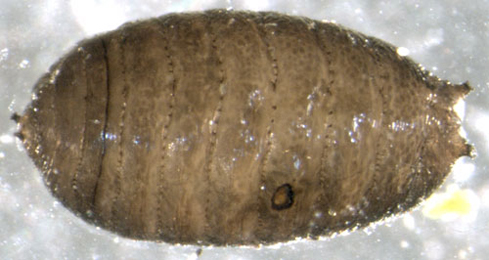|
||||||
|
Phytomyza
angelicae Kaltenbach, 1872 Phytomyza
angelicae Kaltenbach, 1872. Pflanzen-Feinde : 279 |
|||||||||||||||||||||||||||||||||||||||||||||||||||||||||||||||||||||||||||||||||||||||||||||||||||||||||||||||||||||||||||||||||||||||||||||||||||||||||||||||||||||||||||||||||
|
Leaf-miner: Larva forms an upper surface primary blotch with several larvae feeding together; the blotch is greenish when fresh but becomes yellowish with age (Spencer, 1972b: 78 (fig. 257); Spencer, 1976: 376, 377 (fig. 655)). Round or oval blotch, green at first, later yellowish. Young mine are interparenchymatous, only the older mines are truly full depth. Generally several larvae in a communal mine. Pupation outside the mine. Exit slit in lower epidermis (Bladmineerders van Europa). A conspicuous, yellowish, almost circular upper surface blotch. Normally several mines on a leaf which may run together giving the impression of a single mine (British leafminers). Larva: The larvae of flies are leg-less maggots without a head capsule (see examples). They never have thoracic or abdominal legs. They do not have chewing mouthparts, although they do have a characteristic cephalo-pharyngeal skeleton (see examples), usually visible internally through the body wall. The larva is described by Allen (1956, 1957b), Griffiths (1973c), de Meijere (1926) and illustrated in Bladmineerders van Europa ; posterior spiracles with approx. 20 bulbs. Puparium: The puparia of flies are formed within the hardened last larval skin or puparium and as a result sheaths enclosing head appendages, wings and legs are not visible externally (see examples). Black; each side of the anus has a distinct conical projection; posterior spiracles each having an ellipse of some 20 minute bulbs or bulbs (Spencer, 1976: 376). Illustrated in Bladmineerders van Europa.
Hosts in Great Britain and Ireland:
Hosts elsewhere:
Time of year - mines: May, July-November. Time of year - adults: August and April the following year. Distribution in Great Britain and Ireland: Widespread throughout country, from Cornwall to Scotland (Spencer, 1972b: 80) including Inner Hebrides (Isle of Coll) (Bland, 1992), Rum (Bland in Whiteley, 1994), Warwickshire (Bubbenhall) (Robbins, 1991: 66); Caernarvonshire, Cambridgeshire, Denbighshire, Derbyshire, East Sussex, Edinburgh, Glamorgan, Main Argyll, Merionethshire, North Ebudes, North Somerset, Nottinghamshire, Pembrokeshire, Shropshire, South Lancashire, South Somerset, South-west Yorkshire, Stafford, Surrey, West Lancashire and West Norfolk (NBN Atlas). Also recorded in Ireland (Spencer, 1972b: 80). Distribution elsewhere: Europe (Spencer, 1976: 376) including Belgium (Scheirs, de Bruyn and von Tschirnhaus, 1999), Germany (Spencer, 1976: 376), The Netherlands (Bladmineerders van Europa), Austria, Czech Republic, Denmark, Estonia, European Turkey, Finland, French mainland, Iceland, Italian mainland, Lithuania, Norwegian mainland, Poland, Sweden and Switzerland (Fauna Europaea). Range extending eastwards to the Moscow region of Russia (Spencer, 1976: 376). Also recorded in U.S.A. (Griffiths, 1973c) and Canada (Alaska) (Spencer, 1976: 376). NBN Atlas links to known host species:
British and Irish Parasitoids in Britain and elsewhere:
|
| Last updated 10-Jul-2019 Brian Pitkin | ||

